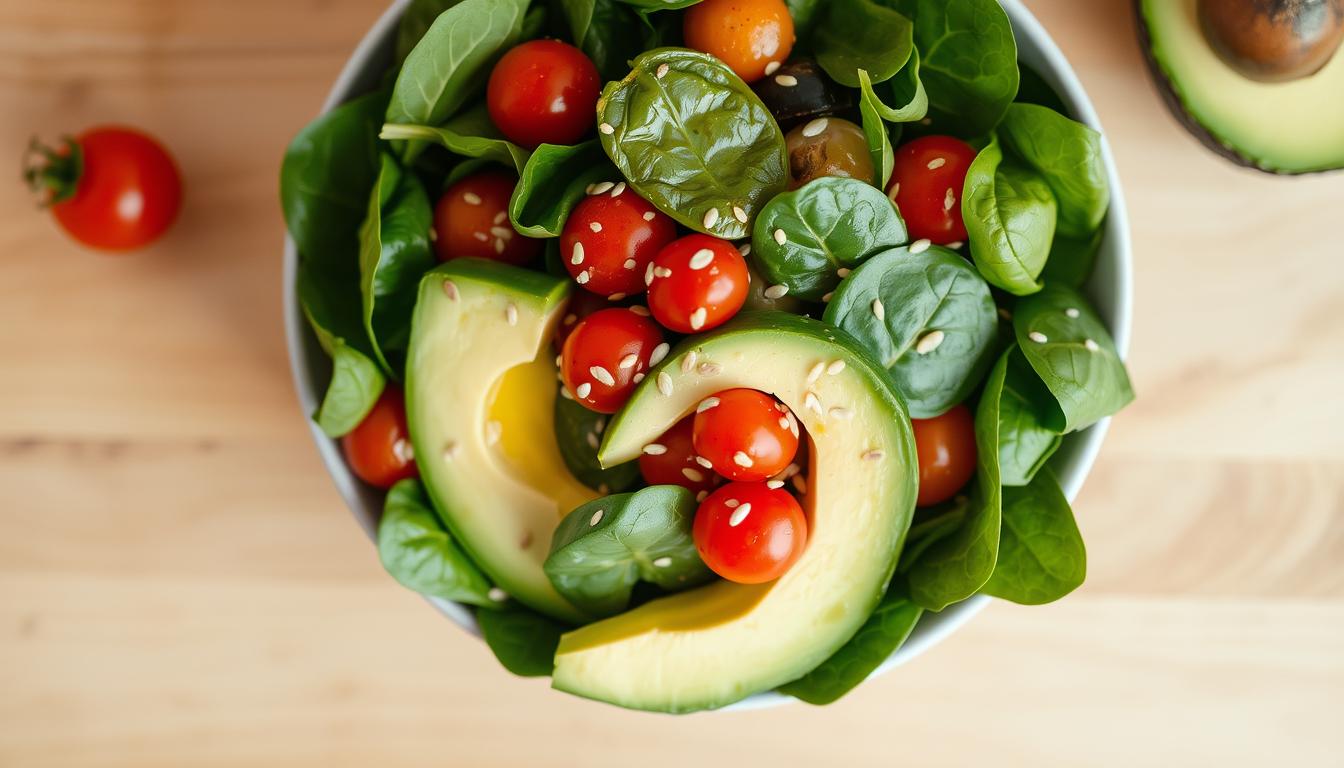Are you tired of dealing with fibromyalgia’s tough symptoms? A simple spinach and avocado salad might help ease your chronic pain and tiredness. Avocados are packed with potassium, even more than bananas, making them a great choice for those with fibromyalgia.
In this article, we’ll look at how this tasty salad can help you manage fibromyalgia. You’ll learn about the amazing benefits of spinach and avocado, two natural fighters against inflammation.
The Perfect Fibromyalgia-Friendly Meal
Living with fibromyalgia means dealing with chronic pain, fatigue, and inflammation every day. But, your diet can help fight these symptoms. This spinach and avocado salad is a great choice because it’s full of nutrients that fight inflammation.
Why This Salad Is Ideal for Managing Symptoms
This salad is packed with nutrients that help manage fibromyalgia symptoms. It has leafy greens, healthy fats, and anti-inflammatory ingredients. The anti-inflammatory properties in the salad can reduce pain and improve your overall health.
- Spinach is a fibromyalgia-friendly superfood, full of vitamins, minerals, and antioxidants that fight inflammation.
- Avocado is a natural anti-inflammatory, with healthy fats and compounds that soothe chronic pain.
- Olive oil, nuts, and berries in the salad add to its anti-inflammatory benefits.
Adding this salad to your diet is a big step towards managing your symptoms. It can help improve your quality of life.
Unleash the Power of Spinach and Avocado
Spinach and avocado are two superfoods that make a great salad for fibromyalgia sufferers. Spinach is full of vitamins, minerals, and antioxidants that fight inflammation. Avocado adds healthy fats that also help reduce inflammation. Together, they create a salad that fights fibromyalgia symptoms.
Spinach is loaded with vitamins A, C, and K to support health and reduce inflammation. It also has magnesium, potassium, and folate to help manage fibromyalgia symptoms. Avocado, with its creamy texture, offers healthy fats, fiber, and vitamins and minerals. These nutrients boost energy, aid digestion, and reduce inflammation.
Adding spinach and avocado to your meals can harness their anti-inflammatory powers. This duo can ease chronic pain, fatigue, and other fibromyalgia symptoms. It empowers you to manage your health and improve your well-being.
| Nutrient | Spinach | Avocado |
|---|---|---|
| Vitamin A | ✓ | |
| Vitamin C | ✓ | ✓ |
| Vitamin K | ✓ | ✓ |
| Magnesium | ✓ | ✓ |
| Potassium | ✓ | ✓ |
| Folate | ✓ | |
| Healthy Fats | ✓ | |
| Fiber | ✓ |
By using spinach and avocado, you can make a tasty salad that helps with fibromyalgia. Adding these anti-inflammatory foods to your diet is a simple way to improve your health and well-being.
Nutrient-Dense Ingredients for Chronic Pain Relief
If you have fibromyalgia, adding nutrient-rich foods to your diet can change your life. Spinach and avocado are two top choices. They’re full of vitamins and minerals and have anti-inflammatory effects that help with chronic pain.
Spinach: A Superfood for Fibromyalgia
Spinach is a leafy green packed with vitamins A, C, and K, and minerals like iron, calcium, and magnesium. These nutrients help fight inflammation and boost your immune system. This is key for managing fibromyalgia symptoms. Eating a diet rich in spinach and veggies can greatly improve your health.
Avocado: Nature’s Anti-Inflammatory Powerhouse
Avocados are full of healthy fats like oleic acid and omega-3 fatty acids. These fats are known for their anti-inflammatory properties. The Mediterranean diet, rich in avocados, has been shown to lessen pain and stiffness in people with arthritis. Plus, avocados are a great choice for those who can’t handle dairy because they’re a good source of healthy fats.
Adding spinach and avocado to your meals can make a big difference. They help create a salad that fights chronic pain from fibromyalgia. This combo of anti-inflammatory foods supports your health and makes managing your condition easier.
The Benefits of an Anti-Inflammatory Diet
Chronic inflammation is thought to cause fibromyalgia. An anti-inflammatory diet includes fruits, vegetables, whole grains, and healthy fats. It helps manage symptoms of this condition. Foods that fight inflammation can ease muscle pain, fatigue, and other fibromyalgia-related issues.
The spinach and avocado salad in this article is a great anti-inflammatory meal for fibromyalgia sufferers. Spinach is full of antioxidants and compounds that fight inflammation. Avocados, with their monounsaturated fats and vitamin E, soothe and prevent inflammation.
Eating more anti-inflammatory foods can greatly reduce your fibromyalgia symptoms. It can lessen muscle pain, boost energy, and improve your overall health.
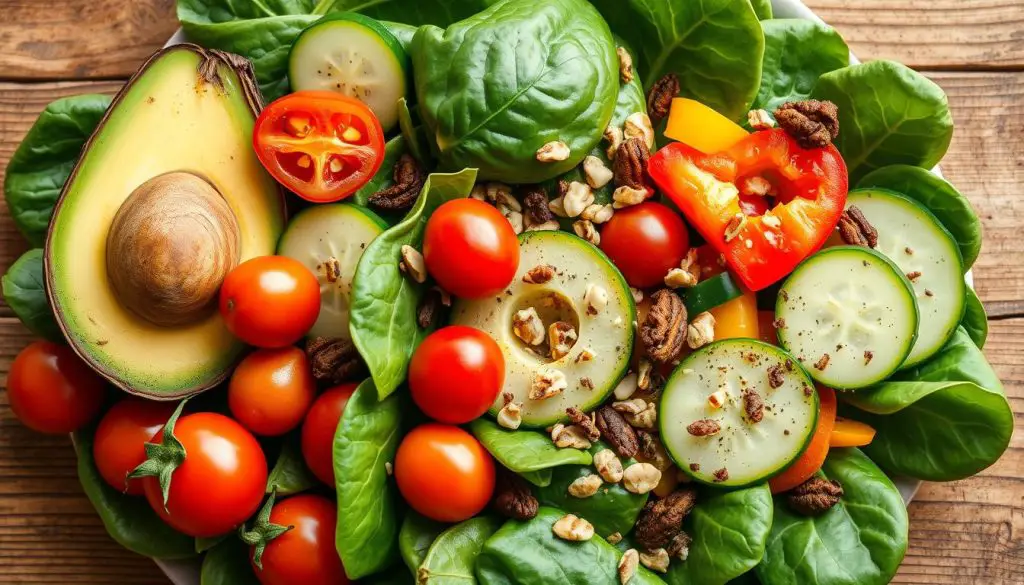
Keep in mind, an anti-inflammatory diet is not for everyone. It’s key to work with your healthcare provider to create a diet plan that fits your needs. With the right diet, you can manage your chronic inflammation and enhance your life quality.
Customizing Your Spinach and Avocado Salad
The beauty of a spinach and avocado salad is its flexibility. It’s packed with nutrients and can be tailored to fit your diet and health goals. Adding low-calorie ingredients makes it a great choice for those managing their weight.
Low-Calorie Additions for Weight Management
To make a salad that’s both filling and healthy, try these low-calorie options:
- Cherry tomatoes – They’re full of vitamins and antioxidants. Cherry tomatoes add color and a sweet flavor without many calories.
- Cucumber – It’s crisp and hydrating. Cucumbers add a refreshing crunch without adding calories.
- A light vinaigrette – Choose a simple vinaigrette with extra virgin olive oil, balsamic vinegar, and lemon juice. This dressing adds flavor without extra calories.
Adding these ingredients turns your spinach and avocado salad into a healthy, filling meal. It supports your health and wellness goals.
Spinach and avocado salad for fibromyalgia
If you’re dealing with fibromyalgia’s chronic pain and fatigue, a spinach and avocado salad can make a big difference. This fibromyalgia-friendly meal is full of nutrients and anti-inflammatory ingredients. It can help ease your symptoms and improve your health.
Fibromyalgia affects about 4 million adults in the U.S. Some diets, like low-calorie and vegetarian ones, may help manage symptoms. Eating foods like spinach and avocado can be very beneficial.
The spinach and avocado salad in this article is great for managing fibromyalgia. It combines nutrients that can reduce inflammation and pain. Adding this salad to your meals is a step towards better health and managing fibromyalgia.
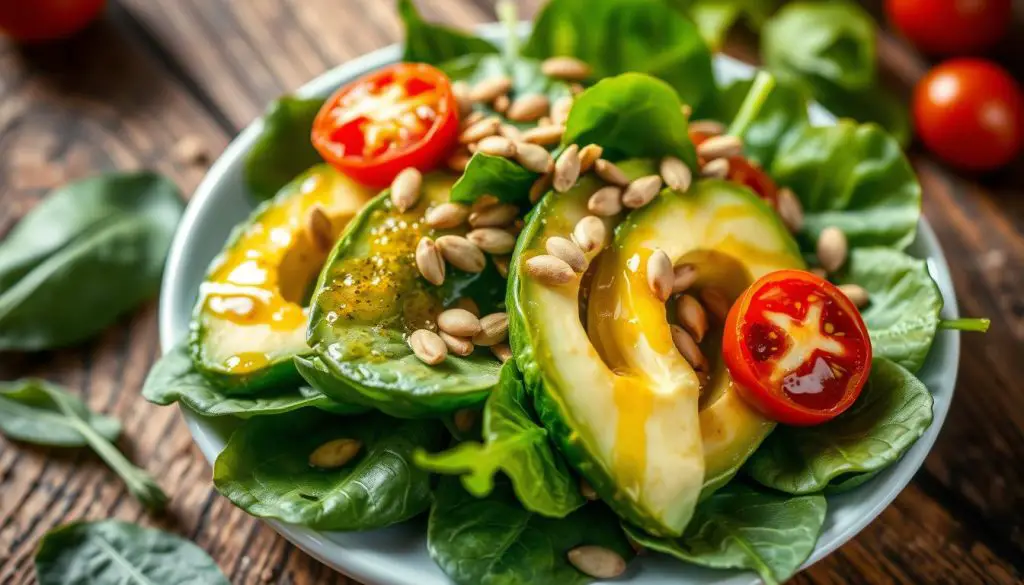
Diets for fibromyalgia focus on fruits, veggies, lean proteins, whole grains, and nuts. The recipes can be tailored for different diets, making them helpful for many people with fibromyalgia.
Keep in mind, what works for one person with fibromyalgia might not work for another. It’s important to work with a registered dietitian. They can help create a diet plan that fits your needs and helps manage your fibromyalgia.
Preparing the Perfect Fibromyalgia-Fighting Salad
Step-by-Step Instructions
Making a tasty spinach and avocado salad to fight fibromyalgia is simple. Just follow a few easy steps. You’ll get a dish full of anti-inflammatory ingredients that can ease chronic pain and fatigue.
- Begin by washing and drying a big batch of fresh spinach leaves well.
- Then, cut the avocado and mix it with the spinach. This adds a nice contrast of green and creamy.
- To boost the anti-inflammatory effects, add ingredients like cherry tomatoes, cucumbers, or a light vinaigrette.
- Mix everything together, making sure the avocado is spread out evenly.
- Season it to taste with sea salt, black pepper, or lemon juice.
By following these steps, you’ll have a tasty salad that fights fibromyalgia. This healthy dish is a smart way to add anti-inflammatory foods to your diet. It gives your body the nutrients it needs to handle fibromyalgia symptoms.
The secret to a great fibromyalgia-friendly salad is using fresh, whole foods. These foods help reduce inflammation and support your health. With a bit of effort, you can make a meal that’s both delicious and helps with fibromyalgia.
Balancing Flavors and Textures
Creating a great spinach and avocado salad is all about balance. The crisp spinach and creamy avocado are a perfect start. Adding ingredients like cherry tomatoes and a light vinaigrette can make it even better.
Choosing the right ingredients is key to a delicious salad. The mix of crunchy spinach and smooth avocado is a joy to eat. The tangy vinaigrette and sweet cherry tomatoes balance the flavors beautifully.
To make the perfect spinach and avocado salad, focus on balancing flavors and textures. Think about the salad composition and pick the best ingredients. This way, you’ll get a dish that’s not only healthy but also tasty.
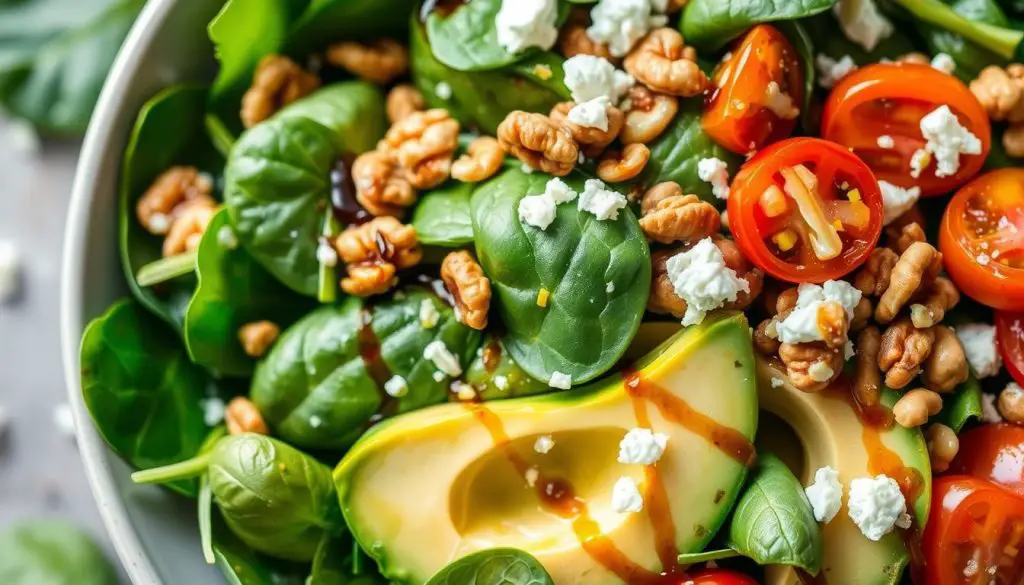
| Ingredient | Nutrient Profile |
|---|---|
| Spinach | Rich in vitamins A, C, and K, as well as folate and iron. |
| Avocado | High in healthy monounsaturated fats, fiber, and a variety of vitamins and minerals. |
| Cherry Tomatoes | Contain antioxidants like lycopene and vitamins C and K. |
| Vinaigrette | Provides a tangy, flavorful dressing with anti-inflammatory properties from ingredients like olive oil and vinegar. |
By using these healthy ingredients and balancing flavors and textures, you can make a spinach and avocado salad. It will not only taste great but also help your health, even when you’re managing fibromyalgia symptoms.
Incorporating Spinach and Avocado into Your Diet
Adding spinach and avocado to your diet can help with fibromyalgia symptoms. These foods are packed with nutrients that fight chronic pain and inflammation. They are key for a diet that helps with fibromyalgia.
Making a salad with spinach and avocado is a tasty way to start. You can have it as a main dish or a side. It’s easy to add these ingredients to other meals too. Eating spinach and avocado regularly can boost your health and ease fibromyalgia pain.
You can also use spinach and avocado in many ways. Blend avocado into smoothies or use it on toast. Spinach is great in soups, omelets, or as a side dish.
By adding spinach and avocado to your meals, you get lots of anti-inflammatory benefits. These ingredients are easy to use and can be a big part of a healthy diet for fibromyalgia.
Tips for Incorporating Spinach and Avocado into Your Diet
- Add spinach to your morning smoothie for a nutrient-packed start to the day.
- Top your toast or crackers with mashed avocado for a creamy and satisfying snack.
- Incorporate spinach into your favorite pasta dishes, stir-fries, or omelets.
- Enjoy a spinach and avocado salad as a main course or side dish.
- Use avocado as a healthy and flavorful replacement for mayonnaise or other spreads.
By making spinach and avocado a regular part of your diet, you can take a proactive step towards managing the symptoms of fibromyalgia and promoting overall health and wellness.
Complementary Recipes for Fibromyalgia Management
Along with the spinach and avocado salad, there are many other complementary recipes good for those with fibromyalgia. These include foods like salmon, berries, and turmeric, which fight inflammation. Also, smoothies and whole grain dishes help with overall health.
Adding these recipes to your diet can help manage fibromyalgia symptoms. Here are some ideas:
- Salmon with roasted sweet potatoes and steamed broccoli: Salmon’s omega-3s reduce inflammation. Sweet potatoes and broccoli add vitamins and minerals.
- Berry smoothie with spinach and almond milk: Berries are full of antioxidants. Spinach and almond milk add more anti-inflammatory benefits.
- Quinoa and vegetable stir-fry: Quinoa gives fiber and complex carbs. Vegetables add nutrients for health.
By trying different complementary recipes, you can help your body and ease fibromyalgia symptoms.
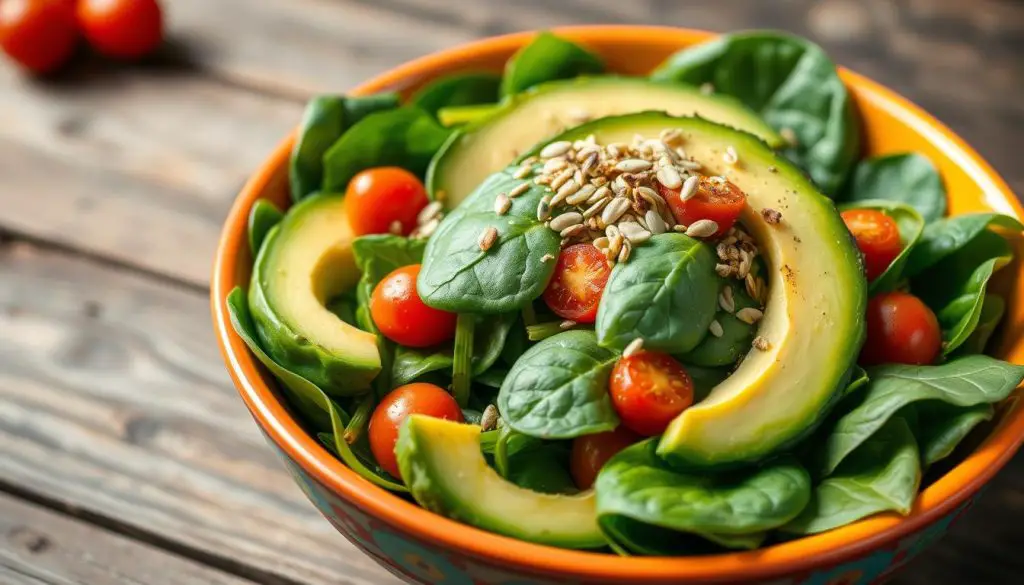
Always talk to your doctor before changing your diet, even if it’s for fibromyalgia. A diet plan that fits your needs is best for managing fibromyalgia.
Lifestyle Tips for Chronic Pain Relief
Eating well is key for managing fibromyalgia, but other lifestyle choices matter too. A balanced, anti-inflammatory diet and lifestyle changes can help. Together, they can improve life quality for those with fibromyalgia.
Stress-reducing activities like meditation or yoga are important. Stress can make fibromyalgia worse. So, finding ways to relax and be mindful is very helpful.
Good sleep is also vital for fibromyalgia patients. Try to sleep 7-9 hours each night. A regular bedtime routine helps your body get into a sleep rhythm.
Light exercise, like walking or swimming, can also help. It’s okay to start slow and not overdo it. Regular activity can make muscles stronger and improve overall health.
| Lifestyle Factor | Benefit for Fibromyalgia Management |
|---|---|
| Stress Reduction | Helps alleviate symptoms by promoting relaxation and mindfulness |
| Quality Sleep | Allows the body to rest and recover, essential for managing chronic pain |
| Gentle Exercise | Improves muscle strength, flexibility, and overall wellbeing |
By following these lifestyle tips, people with fibromyalgia can find relief from chronic pain. A mix of diet and lifestyle changes is the best way to manage fibromyalgia.
The Road to Wellness: A Holistic Approach
Fibromyalgia is a complex condition that needs a holistic approach. This means looking at the physical, emotional, and mental sides of it. The spinach and avocado salad is a good start, but it’s just part of the solution. A balanced diet, lifestyle changes, and other therapies are key to managing fibromyalgia symptoms.
It’s important to tackle the causes of inflammation and pain in fibromyalgia. Eating anti-inflammatory foods, like in this recipe, helps. Also, trying holistic therapies like meditation and gentle exercise can offer relief. Working with a healthcare team that gets fibromyalgia can help create a plan for your well-being.
The road to wellness is unique for everyone. By trying different holistic approaches, you can find ways to better manage your symptoms. Start this journey with kindness to yourself and an open mind to new healing methods.
Source Links
- https://brianbarr.co.uk/about/blog/anti-inflammatory-recipes-for-fibromyalgia-sufferers/
- https://www.paincation.com/seeking-relief-from-fibromyalgia-through-diet-a-hopeful-path-in-a-sea-of-doubts-rss/
- https://www.realsimple.com/food-recipes/recipe-collections-favorites/best-anti-inflammatory-recipes
- https://www.healthline.com/nutrition/salad-for-breakfast
- https://www.eatingwell.com/article/7866119/rheumatoid-arthritis-diet-plan/
- https://www.healthline.com/health/rheumatoid-arthritis/seven-day-meal-plan
- https://www.arthritis.org/health-wellness/healthy-living/nutrition/anti-inflammatory/the-ultimate-arthritis-diet
- https://www.confrontingchronicpain.com/your-nutrition-plan-for-chronic-pain/
- https://www.londonpainclinic.com/alternative/nutrition-for-pain-management/
- https://www.medicalnewstoday.com/articles/323164
- https://www.eatingwell.com/article/7763510/best-breakfasts-for-inflammation/
- https://www.fibromyalgiatreatment.net/dietary-changes-eating-an-anti-inflammatory-diet
- https://curearthritis.org/recipes/tuna-and-avocado-mediterranean-salad/
- https://curearthritis.org/recipes/spinach-with-grilled-chicken-wrap/
- https://www.healthline.com/nutrition/fibromyalgia-diet-recipes
- https://livingwithfibromyalgia.org/fibromyalgia-friendly-recipes/
- https://www.allrecipes.com/article/cooking-oils-anti-inflammatory-diet/
- https://www.healthline.com/nutrition/healthy-salad-toppings
- https://www.eatingwell.com/gallery/8053593/high-protein-anti-inflammatory-smoothies/
- https://www.holisticlighttherapy.co/blog-manager/2018/7/31/can-eating-whole-foods-reduce-inflammation
- https://www.thefibroguy.com/blog/hypermobility-diet/
- https://www.tuasaude.com/en/liver-detox/
- https://forum.livingwithfibro.org/t/suggestions-for-snacks-food-recipes-that-help-with-inflammation/11193
- https://www.webmd.com/rheumatoid-arthritis/ss/slideshow-foods-rheumatoid-arthritis
- https://wellspring-hc.com/dealing-with-pain-inflammation-your-diet-may-be-to-blame/
